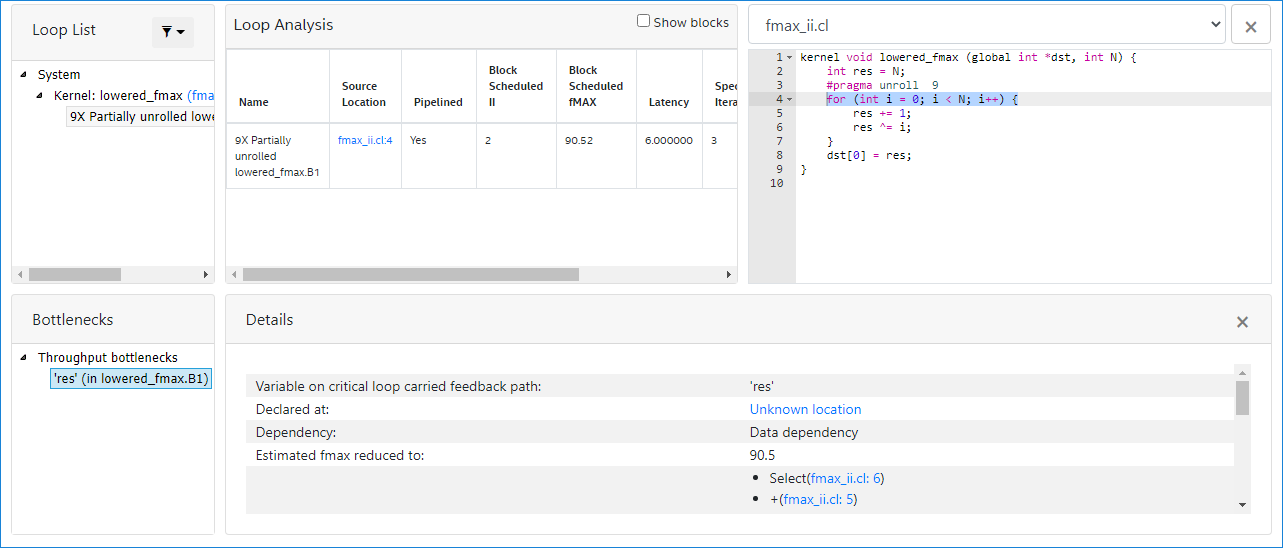Intel® FPGA SDK for OpenCL™ Pro Edition: Best Practices Guide
A newer version of this document is available. Customers should click here to go to the newest version.
3.4.6. Loop Bottlenecks
Before analyzing the throughput of a simple loop, it is important to understand the concept of dynamic initiation interval. The initiation interval (II) is the statically determined number of cycles between successive iteration launches of a given loop invocation. However, the statically scheduled II may differ from the actual realized dynamic II when considering interleaving.
In the presence of interleaving, the dynamic II of a loop can be approximated by the static II of the loop divided by the degree of interleaving, that is, by the number of concurrent invocations of the loop that are in flight.
Simple Loop Example
In a simple loop, the maximum number of data items to be processed concurrently (also known as maximum concurrency) can be expressed as:
ConcurrencyMAX = (Block latency × Maximum interleaving iterations) / Initiation Interval
Consider the following simple loop:
1 kernel void lowered_fmax (global int *dst, int N) {
2 int res = N;
3 #pragma unroll 9
4 for (int i = 0; i < N; i++) {
5 res += 1;
6 res ^= i;
7 }
8 dst[0] = res;
9 }The Loop Analysis report displays the following for the simple loop:

The for loop in line:4 has a latency of 6, maximum interleaving iterations of 1, and initiation interval of 2. So, the maximum concurrency is 3 (latency of 6 / II of 2). The bottleneck results from loop carried dependency caused by a data dependency on the variable res. This is reported in the Bottlenecks viewer as shown in the following image:

Another type of loop carried dependency is memory dependency, as shown in the following example:
for (…)
for (…)
… = mem[x];
mem[y] = …;
Nested Loop Example
In a nested loop, the maximum concurrency is more difficult to compute. For example, the loop carried dependency in a nested loop does not necessarily affect the initiation interval of the outer loop. Additionally, a nested loop often requires the knowledge of the inner loop's trip count. Consider the following example:
1 __kernel void serial_exe_sample( __global unsigned* restrict input,
2 __global unsigned* restrict output,
3 int N ) {
4 unsigned offsets[1024];
5 unsigned size[1024];
6 unsigned results[4];
7 for (unsigned i = 0; i < N; i++) {
8 offsets[i] = input[i];
9 }
10
11 for (unsigned i = 1; i < (N-1); i++) {
12 unsigned num = offsets[i];
13 unsigned sum = 0;
14 // There's a memory dependency, so the inner loops are executed
15 // serially, i.e. the both loops finish before the next iteration
16 // of i in the outer loop can start.
17 for (unsigned j = 0; j < num; j++) {
18 size[j] = offsets[i+j] - offsets[i+j-1];
19 }
20 for (unsigned j = 0; j < 4; j++) {
21 results[j] = size[j];
22 }
23 }
24
25 // store it back
26 #pragma unroll 1
27 for (unsigned i = 0; i < 4; i++) {
28 output[i] = results[i];
29 }
30 }In this example, the bottleneck is resulted from loop carried dependency caused by a memory dependency on the variable size. The size variable must finish loading in the loop in line:20 before the next outer loop (line:11) iteration can be launched. Therefore, the maximum concurrency of the outer loop is 1. This information is reported in the details sections of the Loop Analysis and Schedule Viewer reports.
Addressing Bottlenecks
To address the bottlenecks, primarily consider restructuring your design code .
After restructuring, consider applying the following loop pragmas or attributes on arrays:
- #pragma II. See Specifying a loop initiation interval (II) in the Intel FPGA SDK for OpenCL Programming Guide
- #pragma ivdep safelen. See Removing Loop-Carried Dependencies Caused by Accesses to Memory Arrays
- #pragma max_concurrency. See Loop Interleaving Control in the Intel FPGA SDK for OpenCL Programming Guide
- attribute private_copies. See Specifying the private_copies Memory Attribute in the Intel FPGA SDK for OpenCL Programming Guide
Consider the previous Simple Loop Example where the concurrency is 3 as the initiation interval is 2. Applying #pragma II 1, as shown in the following code snippet, comes at the expense of lowered predicted fMAX from 90MHz to 50MHz:
1 kernel void lowered_fmax (global int *dst, int N) {
2 int res = N;
3 #pragma unroll 9
4 #pragma ii 1
5 for (int i = 0; i < N; i++) {
6 res += 1;
7 res ^= i;
8 }
9 dst[0] = res;
10 }